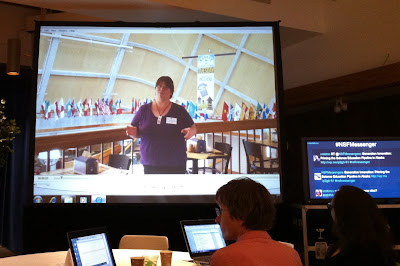 |
| L to r: Dr. Sharon Chamard, Dr. Troy Payne, and Barbara Armstrong at the UAF Wood Center, site of the workshop. |
The “Science: Becoming the Messenger” workshop, which is offered by NSF all over the nation, equips attendees with the skills and techniques communications professionals use to influence people’s thinking and attitudes, and demonstrates how these skills can be used to win support for research. The workshop was led by three experienced science communicators, and covered strategies from crafting a message to delivering it - using both traditional and new media.
 |
| Dr. Chamard on screen in the video shown at the workshop. |
Dr. Chamard's video was chosen by the workshop leader, Joe Schreiber, to use as an example of how to edit and use still photos with a video. Mr. Schreiber took the raw video, edited it, inserted appropriate stills related to the topic, then showed it to the group.
In the video, Dr. Chamard explains that her project would look at spatial predictors for where homeless encampments are located, and the environmental impact of those encampments, including the risk of accidental/intentional fires, habitat destruction, and health and sanitation issues. Using spatial predictors, public agencies and social service providers could more easily find homeless encampments. This would allow them to offer alternative housing arrangements to campers, and close the camps before they become so large and entrenched that they are environmental hazards.
Among other UAA community members who attended the program were Dr. Diane Hirshberg, Director, Center for Alaska Education Policy Research; Prof. Mara Kimmel, Dept. of Political Science & ISER; Dr. Bridget Hanson, Research Assistant Professor, Center for Behavioral Health Research and Services; and Dr. Jonathan Alevy, Economics Department.
Dr. Hirshberg was one of the attendees selected to present her proposed project to the entire workshop audience. The audience voted on whether projects should hypothetically be funded or not, and Dr. Hirshberg successfully convinced the group that her project - which focused on education in Alaska - should be awarded foundation support. Her next assignment was a mock interview with a real-life journalist during which she had to defend her project and the hypothetical funding award. Dr. Hirshberg persuasively answered all the challenges and questions put to her during the interview.
 |
| On stage: Dr. Hirshberg (r) is interviewed by Chris Mooney, a Washington, D.C. journalist. |
